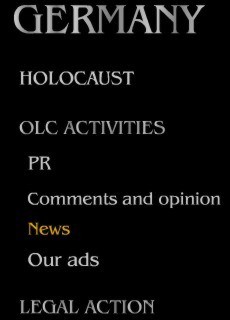|
Archaeologist Daniel Schavelzon admits his shock ‘discovery’ was ‘just speculation’.
There is little evidence that a group of buildings in the Argentinian jungle was a secret hideout for Nazi war criminals and in fact probably predated World War II by many years, the researcher who made the supposedly shocking find told the Guardian Monday.
The stone structures, located in the steamy heart of the Teyú Cuaré national park, were touted as having been recently discovered by archaeologist Daniel Schavelzon, who suggested they were used by on the run Nazi war criminals after Germany’s defeat.
But Schavelzon said linking the find of some German coins and other wares to a supposed Nazi bolt-hole was “speculation on my part” that was blown out of proportion by the press.
“There is no documentation, but we found German coins from the war period in the foundations,” Schavelzon said.
The University of Buenos Aires researchers found five German coins minted between 1938 and 1941 and a fragment of porcelain plate bearing the inscription “Made in Germany” the local Clarin newspaper reported at the beginning of the week.
However, according to the Guardian report, the buildings were already open to the public decades ago and other ruins close by date back to 17th and 18th century when they were used by Jesuit missionaries.
Nearby is San Ignacio Miní, a Baroque monastery that draws many tourists.
Although a sign on the ruins notes their connection the Jesuit site it also claims that “in the 1950s they were refurbished and inhabited by Hitler’s most faithful servant, Martin Bormann.”
Yet the Guardian suggested Bormann’s residency was more likely a mistake based on fake files sold in the 1970s by Argentinian police officers to Hungarian historian Ladislas Farago. In addition, a DNA test in 1998 proved that bones held in Berlin were those of Bormann and that he was killed as he tried to flee the city in 1945.
As for the coins, they could have been dropped by any of the multitude of immigrants who arrived Argentina and according to the report there are some three million Argentinians of German descent in the country today.
Nonetheless, after the war thousands of Nazis, Croatian Ustasha fascists and Italian fascists did arrive in Argentina with the blessing of president Juan Peron, who led the nation from 1946 to 1955 and again briefly in the 1970s, according to the Nazi-hunting Simon Wiesenthal Center. Rather than living in secret jungle bunkers they found homes on the outskirts of Buenos Aires.
In 1960, Nazi Adolf Eichmann, who helped organize the Holocaust, was captured in Buenos Aires by an Israeli commando team and tried in Israel where he was executed.
Among other Nazis who sought refuge in Argentina were Josef Mengele, Walter Kutschmann, Josef Schwammberger, Eduard Roschmann, Wilfred Von Oven, and Alois Brunner.
timesofisrael.com
|


